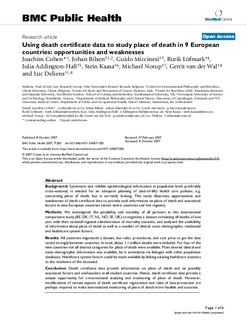| dc.description.abstract | Background: Systematic and reliable epidemiological information at population level, preferably
cross-national, is needed for an adequate planning of (end-of-life) health care policies, e.g.
concerning place of death, but is currently lacking. This study illustrates opportunities and
weaknesses of death certificate data to provide such information on place of death and associated
factors in nine European countries (seven entire countries and five regions).
Methods: We investigated the possibility and modality of all partners in this international
comparative study (BE, DK, IT, NL, NO, SE, UK) to negotiate a dataset containing all deaths of one
year with their national/regional administration of mortality statistics, and analysed the availability
of information about place of death as well as a number of clinical, socio-demographic, residential
and healthcare system factors.
Results: All countries negotiated a dataset, but rules, procedures, and cost price to get the data
varied strongly between countries. In total, about 1.1 million deaths were included. For four of the
nine countries not all desired categories for place of death were available. Most desired clinical and
socio-demographic information was available, be it sometimes via linkages with other population
databases. Healthcare system factors could be made available by linking existing healthcare statistics
to the residence of the deceased.
Conclusion: Death certificate data provide information on place of death and on possibly
associated factors and confounders in all studied countries. Hence, death certificate data provide a
unique opportunity for cross-national studying and monitoring of place of death. However,
modifications of certain aspects of death certificate registration and rules of data-protection are
perhaps required to make international monitoring of place of death more feasible and accurate. | nb_NO |
